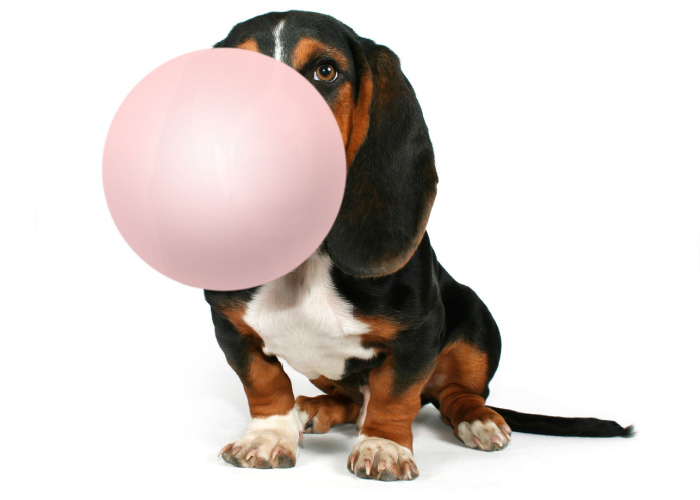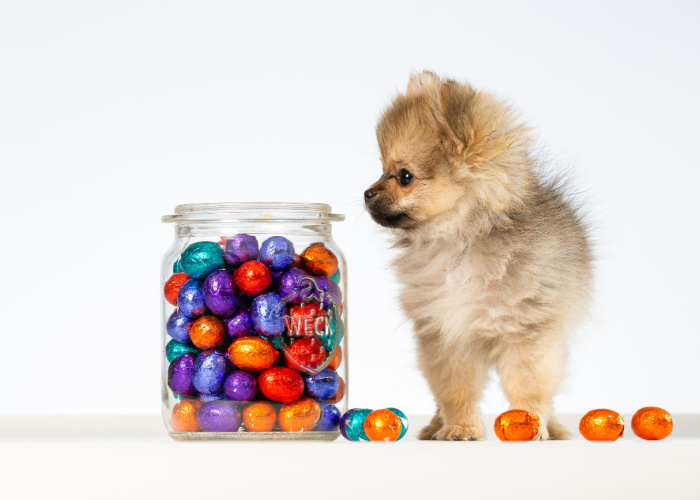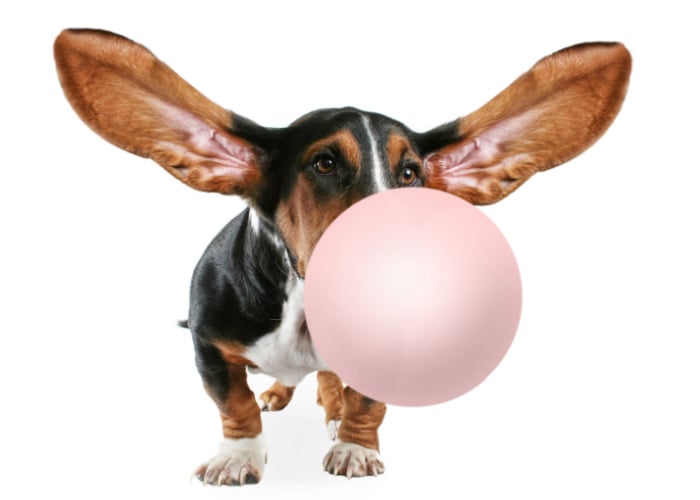
Table of Contents
Suppose you're a pet owner that enjoys the occasional sweets.
It would be best if you were cautious in hiding these confectioneries.
Trust me. You wouldn't want to call your vet saying, “Hey Doc, my dog ate gum! What should I do next?”
If you've accidentally left your bag open and you caught Fido chewing on gum, you'll need to act fast.
Some chewing gums contain Xylitol. If you're a new pet parent unaware of this, xylitol is extremely dangerous for your pup.
Chewing gums, if swallowed, can also cause an intestinal blockage, which can stop food from passing.
This blog will discuss the possible effects of your dog eating gum and what you should do in if and when this situation happens.
Without further ado, let's get right into it!

My Dog Ate Gum: What Should I Do?
“My dog ate gum! What should I do?”
Many pet owners have experienced that moment when they'll catch their pup munching on something they're not allowed to.
And if this ‘something' is chewing gum, you'll need to know what to do next, if this is life-threatening, and if this requires medical attention.
A dog's digestive system differs from that of humans, and gum is one of the foods your dog should not eat.
In some cases, dogs will be fine after eating a piece of gum and show no signs of illness.
However, some dogs can become very sick and require immediate medical attention.
At first glance, you might think that dogs eating chewing gum shouldn't be a big deal since plenty of us have swallowed gum as a kid. (I know I have!)
But the truth is gum can be very harmful to dogs due to a common sweetener found in sugar-free gum called xylitol.
What is Xylitol?
Xylitol is a low-calorie artificial sweetener that is highly poisonous for dogs.
It's a great sugar substitute many manufacturers use since its sweetness is similar to sugars but has fewer calories.
Xylitol is a type of carbohydrate that does not contain alcohol.
It is often used as a tabletop sweetener, or it can also be used in baking.
Even though xylitol is safe for people, it can harm dogs.
How Much Xylitol Can Make A Dog Sick?
Xylitol is so dangerous that a stick of gum can be enough to poison a small dog.
Generally, it takes 0.05 grams of xylitol for every pound of a dog's weight to cause negative effects.
Chewing gums usually have 0.22 to 1 gram of xylitol per piece.
Now if you have a small, 10-pound dog, one piece of gum can be toxic to them.
Foods and Products that Frequently Contain Xylitol
But chewing gum is not the only thing you should look out for.
There are still many products that contain xylitol.
Below, we've listed other types of food that contain xylitol.
If you own any of these items, ensure it is locked somewhere dogs don't have access to.
- Sugar-free candy
- Other types of Peanut Butter
- Yogurt
- Mouthwashes
- Baked goods
- Medications
- Supplements
- Jell-o
- Protein bars
- Ketchup
- Barbecue sauce
- Pancake syrups

What to Watch for in the First 30 Minutes to 1 Hour
Usually, it takes about 10 to 24 hours for something to pass through a dog's digestive system.
Unfortunately, gum is almost impossible to break down.
If your dog has swallowed gum, you must monitor them for about 24 hours. However, it's still best advised to contact your vet right away!
Serious symptoms will often show in the first 30 to 60 minutes.
But xylitol poisoning is not the only thing you should look out for.
A dog swallowing gum can cause intestinal blockage when the dog also eats the wrapper.
It can take a few days before the symptoms of blockage become clear.
Signs of blockage include:
- Vomiting
- Constipation
- Lack of appetite
- Abdominal pain
X-rays will be needed to determine the severity of the blockage.
If the gum is stuck, surgery will be required.
Symptoms of Xylitol Toxicity in Dogs
When a dog eats gum with xylitol, it is quickly absorbed into its bloodstream.
Usually, it'll take as fast as 30 to 60 minutes for the effects of poisoning to start showing.
Yes, time is of the essence when it comes to these types of situations.
Contact, or better yet, rush your pup to the vet if you know that your dog has consumed gum or any food that contains xylitol.
Next, it usually leads to low blood sugar or hypoglycemia caused by a huge insulin release into the body.
Other few signs of xylitol poisoning are listed below:
- Vomiting
- Constipation
- Lack of appetite
- Stumbling
- Pale gums
- Lethargy
- Seizures
- Tremors
- Coma
- Liver damage
- Rapid heartbeat
- Incoordination
- Intestinal upset
Factors That Influence the Severity of Xylitol Poisoning
Even though xylitol can cause serious problems quickly, there are still factors that influence the severity of xylitol poisoning.
It's best to act quickly if you suspect your dog ate something that contains xylitol so that it can recover quickly with suitable veterinary care.
Size of Your Dog
The first factor that can affect the severity of xylitol poisoning is the size of your dog.
Large-sized dogs have more body mass and larger livers than small or toy-sized dogs.
These large dogs are much more likely to recover from eating sugar-free gum than small-sized dogs.
Amount of Gum Consumed
The more dose of poisonous substance your dog consumes, the harder for them to recover from it.
Unfortunately, even small doses of xylitol can cause huge damage in this case.
For instance, a 10kg dog only needs to eat 1 gram of xylitol to end up in the vet clinic.
Also, some single pieces of sugar-free gums have more than a gram of xylitol.
Pre-Existing Medical Conditions
Dogs that are suffering from pre-existing medical problems are more at risk or will suffer from severe xylitol poisoning.
If your dog is hypoglycemic or suffering from diabetes, liver disease, or pancreatic disorders, take him straight to the vet if you suspect he has eaten chewing gum.
Dog Xylitol Poisoning Treatment
Your vet will determine the proper treatment depending on the symptoms shown and the amount of gum ingested.
In some cases, induced vomiting is recommended before taking their dog to the vet.
Once at the clinic, the vet will need to take the dog's vitals which will most likely induce vomiting (if not yet done) and administer activated charcoal to absorb xylitol in the gastrointestinal tract.
The dog's blood sugar and liver function will also be monitored since some dogs suffer from clotting issues after eating foods with xylitol.

Frequently Asked Questions
How quickly does xylitol affect dogs?
Xylitol toxicity will show signs within 30 minutes for most dogs. However, some cases can take up to 8 to 12 hours.
That's why if you know your dog has eaten something that has xylitol in it, don't take the risk and contact your most trusted vet right away.
How do I know if my dog ate something and has a blockage?
It is dangerous for dogs to eat foreign objects since they can get stuck to their intestinal tract, causing a partial or complete obstruction.
A few symptoms of intestinal blockage are diarrhea, vomiting, abdominal pain, and loss of appetite.
Can a dog survive eating xylitol?
Xylitol is extremely toxic to dogs. But dogs can still survive if they only eat small amounts of it by having proper medication and monitoring.
However, even small amounts of xylitol can still cause damage, such as low blood sugar, seizures, liver failure and death.
My Dog Ate Gum: Before You Go…
“What do I do? My dog ate gum!”
If your dog has eaten gum, you should check if the gum contains Xylitol.
If so, contact your vet immediately and rush Fido to the vet as soon as possible, especially if your dog is small and suffers from pre-existing medical problems.
Xylitol is extremely toxic to dogs, even in small amounts.
It is absorbed into the dog's bloodstream, where it causes the pancreas to release insulin, which can cause hypoglycemia or low blood sugar.
It can also cause seizures, liver failure, and death.
Keep in mind that these severe side effects can take effect in 10 to 60 minutes!
If your dog has eaten plenty of gum, it can also cause intestinal blockage, blocking all food from passing.
As pet owners, we must monitor our pets. We should know the things or foods that they should never get their paws on.
If you're the type of person that loves chewing gum, ensure that you keep these types of candies in a locked drawer or a sealed jar where dogs can't reach it.
Is your dog a chewer? Then you might have more questions about the things your dog accidentally eats!
Check out our recommended articles below.












